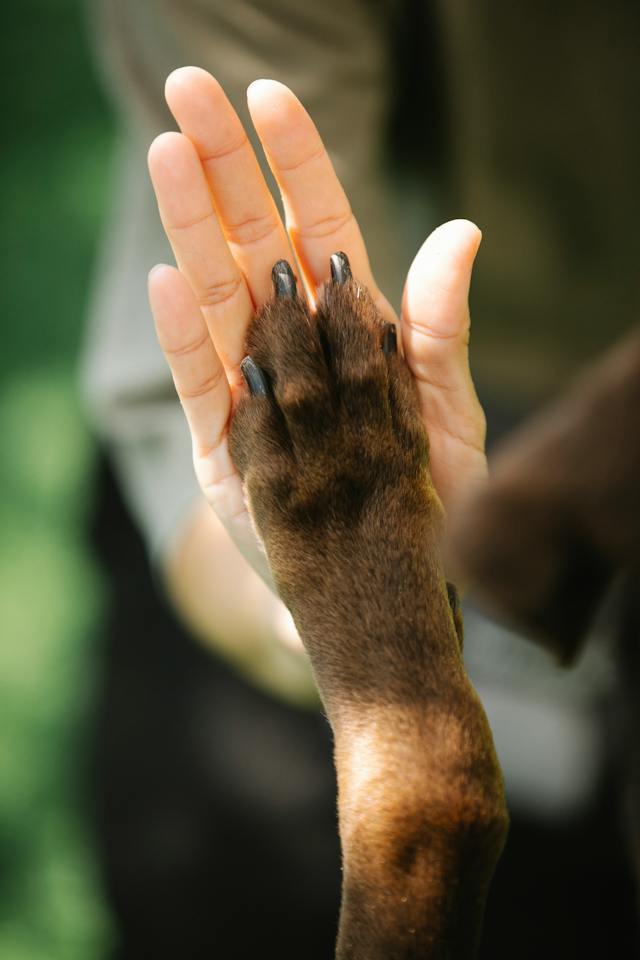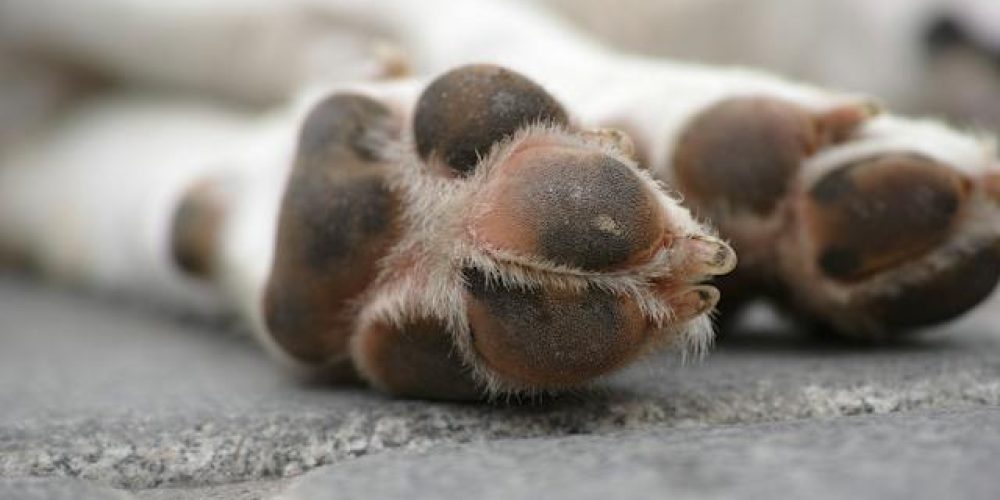6 reasons pads are amazing, 6 common problems with pads and a few tips on how to care for them.
6 fun facts around pads
1. Dogs have 5 pads on each foot
One on each of their 4 toes – the digital pads. And a big heart-shaped pad – this is called the metacarpal pad on the front foot, and the metatarsal pad on the back.
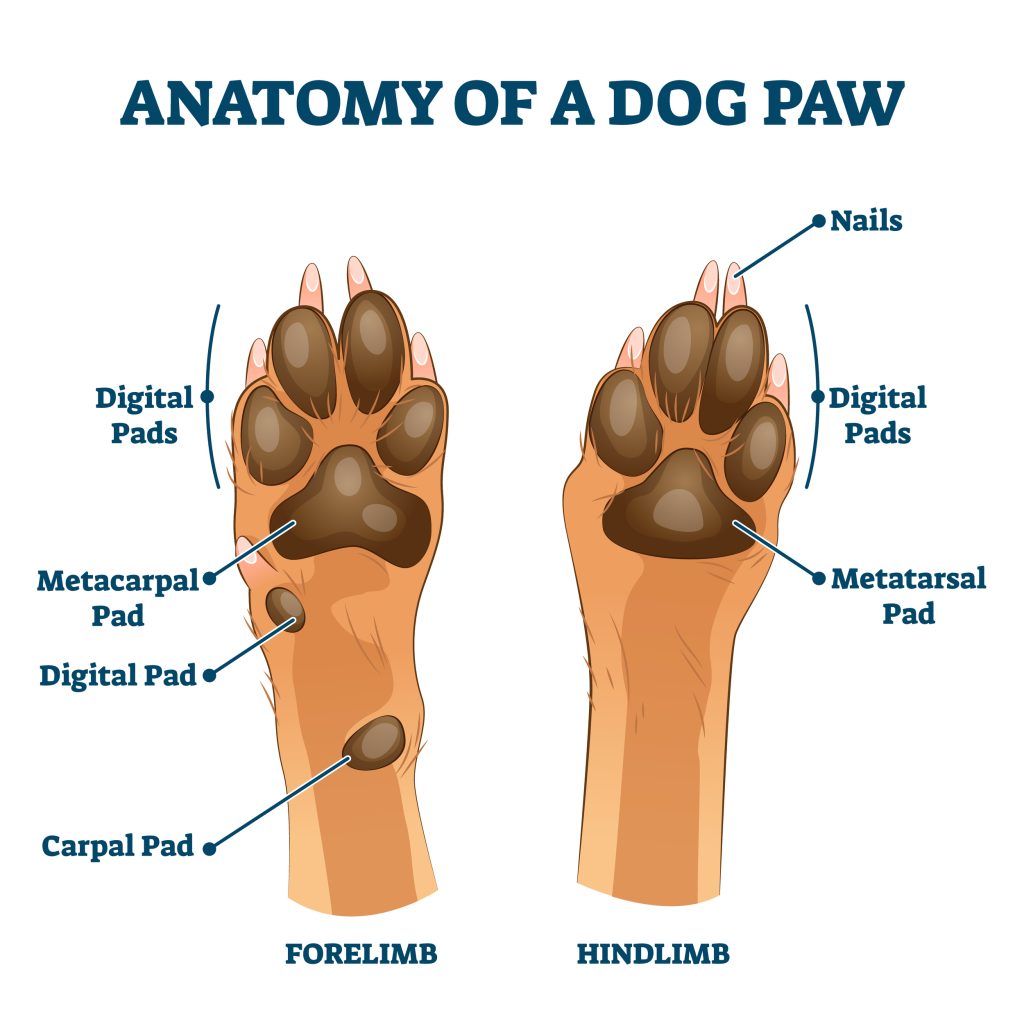
2. Dogs walk on tiptoes
Their digital pads are equivalent to the pads of our fingers and toes. The heart shaped pads are like the fleshy heels of our palms and feet.
3. Dogs have an extra cone-shaped pad on their front legs
The carpal pad. They only touch the ground when your dog makes an abrupt halt or turn.
4. Pads have 2 main layers
A thick fatty layer with a rich blood supply and lots of elastic tissue in it for added bounce. And a thick protective skin covering.
5. Pads come in various colours
Black, pink or even white. And sometimes all on the same dog!
6. Pad thickness varies between dogs
An all-terrain working dog will have thicker, harder pads than our canine couch potatoes – a bit like us and callused hands (or not, as the case may be!)
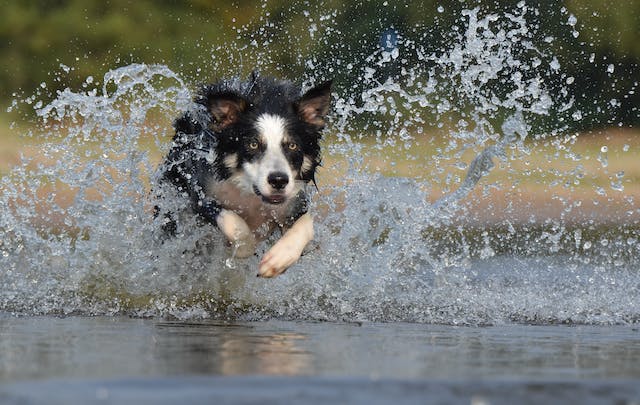
6 superpowers of pads
Mother nature really outdid herself with pads. Little else has so many vital rules in a dog’s daily life. And she keeps them hidden under their feet!
The hidden strengths of pads:
1. A tough pair of walking shoes
Protecting the feet from injury, cold, infection and discomfort on just about any surface
2. Tyre treads
Reliable grip and road-holding. Essential for those twists, turns and sudden stops of everything from zoomies and ball chases to sheep trials and mountain rescue. This is where the carpal pads come in!
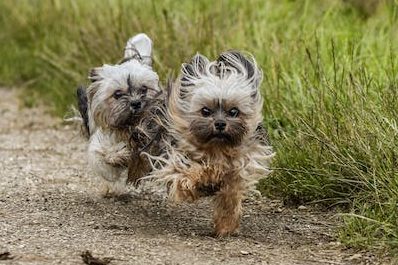
3. Shock absorbers
The fatty springy layer of the pad absorbs the impact when your dog runs and jumps. Protecting the muscles, ligaments and joints of their legs from strain and damage.
4. Raising a sweat?
Ever noticed your dog leaving damp paw marks on the ground on a hot day? Or on the table at the vets, when they’re less-than-happy to be there? That’s because dogs sweat through special glands in their paw pads – the merocrine glands.
5. Hot water bottles
Fatty tissue in pads won’t freeze – so dogs can be all terrain moochers whatever the weather. But it gets even weirder – and more amazing – when you know why. Dogs are just like penguins and dolphins! Arteries and veins are very close together in pads. So arteries carrying warm blood (with oxygen) from the body (heart), transfer heat to veins going back into the body from the pads. This keeps the pads warm. But it also helps keep the body warm since warmer blood gets back to the body.
6. Mini Brains!
Pads are full of nerve endings. They’re sensitive to pain. But they also communicate with your dog’s brain – telling it about position, temperature, pressure and anything else needed to judge and make instant and controlled movements.
6 common health problems of pads
What they are, what to look for and what to do! Follow the links to find out more in our Joii A-Z Health guide.
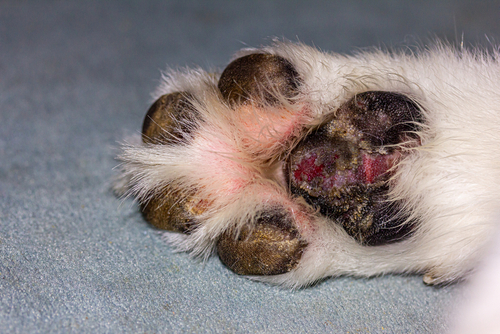
1. Cuts and foreign bodies
Pads are on the frontline of your dog’s encounters with pavements, sand, grass, carpet and a host of other surfaces. Mostly the thick hard surface – keratin- is tough enough to cope with the daily assault of walking, running, jumping, playing and even zoomies. Broken glass is always a hazard. And thorns, sharp metals or gravel can all get into pads. Sometimes overgrown nails can curl around and pierce the pad, causing miserable discomfort every time the affected dog walks.
2. Cracks and splits
Cold weather, grit and salt also result in pads drying and splitting in winter. Hyperkeratosis – thickened and split ‘skin’ on the nose and pads of affected dogs. Dogues de Bordeaux, Irish terriers, Labradors, and Golden Retrievers. Other causes of hyperkeratosis on pads include viruses (distemper), scarring or tiny foreign bodies.
3. Corns or keratomas
Harmless growths of keratin, the hard outer material of pads and nails. Most common in greyhounds. Likely due to chronic pressure and stress on parts of the pad. Cause pain and inflammation.
4. Pododermatitis
Nasty inflammation affecting the skin of the paw, including the pads. Sometimes chronic inflammation and swelling leads to formation of ‘false’ pads. Causes include skin allergies, abnormal conformation (body shape and weight-bearing) and obesity.
5. Burns and blisters
Hot surfaces that would burn our feet will scorch the pads of a dog. And caustic chemicals, like bleach and other strong cleaning fluids are also a risk. Even running on a hard surface will blister pads.
6. Warts – papilloma virus
Small cauliflower-like growths, which grow on the paws, mouth and face. Most common in very young or old dogs or dogs whose immune system isn’t working properly.
Warning signs of problems with your dog’s pads
- Bleeding
- Limping
- Licking
- Swelling
- Not wanting to walk on hard surfaces
- Redness between the toes
- Pain: yelping or whimpering
What to check for and what to do at home
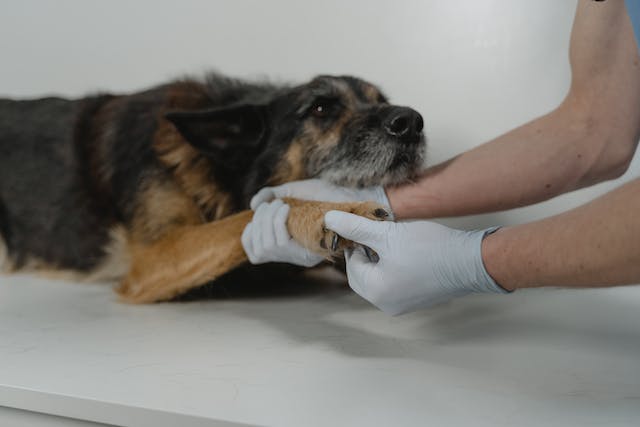
Sudden limping or bleeding
- If you’re out for a walk, check immediately for cuts or anything trapped in the foot. Then head straight home.
- Bathe with boiled cooled water or using the shower head and check for cuts or puncture wounds. Carefully remove anything sticking in the pad or between the toes, but only if you and your dog are both comfortable with this!
- Squeeze gently on each pad in turn. If there’s a thorn buried beneath the surface, pressing over it will cause pain. Be careful not to get bitten!
- Cover the paw with a clean cotton sock secured (but not too tightly) with household tape to protect paw and carpets!
- Apply a cone collar to prevent licking (think of all those bacteria from dog mouths and tongues)
- Call the vet!
Licking, limping or not wanting to walk on hard ground
- Check the paw and pad for redness, swelling or broken nails.
- Make sure the nails haven’t overgrown and curled into the pad.
- Check between the toes and pads for inflammation, cysts or sinus tracts (open weeping punctures caused by foreign bodies)
- Check for growths, cracks or hard patches on the pad. Press gently to see if they are the cause of discomfort – again, with caution!
- Call a vet for advice.
Suspected burns from heat or caustic chemicals
- Carry or lead your dog to safety if they wander onto a hot or caustic surface.
- Rinse off harmful chemicals as much as possible.
- Soak the paw in cool (not ice-cold) clean water for heat burns.
- Call a vet without delay.
- Wrap the paw in a clean damp cloth until you get to the vet.
How to prevent pad problems
- Clean your dog’s feet thoroughly after winter walks: get rid of all the trapped ice, mud, salt, gravel and chemicals that can cause problems later on.
- Don’t forget to dry their feet too.
- Keep an eye out for litter, broken bottles and worse.
- Check nails regularly and trim as required. Some regular walks on hard surfaces will help to wear them down.
- Keep dogs away from real fires and recently-bleached surfaces.
- Don’t take your dog running or on long hikes without building up gradually. You’re not the only one who’ll get blisters!
- Use paw balms and waxes to keep your dog’s paws more supple and to reduce cracking.
And let’s look after those multitasking little miracles!
